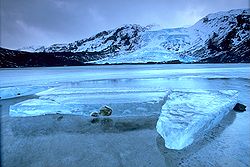Stefano Rossignoli 23 maggio 2010
Immagino che sia chiaro che l’idea per questo articolo mi è venuta osservando come tutti l’eruzione del vulcano islandese presso il ghiacciaio Eyjafjallajokull, ma anche le domande degli amici, tra cui Davide da oltre oceano, mi hanno spinto a scrivere di vulcani.
Ovviamente l’interesse della massa si è dedicato al blocco del traffico aereo in Europa conseguente all’abbondante emissione di ceneri vulcaniche.
Cerchiamo però di capire che tipo di vulcano è e come si comporta questo ‘Colosso Islandese’…
Per prima cosa è importante capire in che zona strutturale della Terra si trova l’ Islanda:
anche nei corsi di Gelogia più elementari, insegnano che quest’isola è una parte integrante della Dorsale Medio-Atlantica.
Come spiegavo nell’articolo a cui vi rimando, In corrispondenza delle dorsali si forma la crosta oceanica ovvero nuovo fondale oceanico.
L’islanda si trova su una dorsale che continua ad essere attiva da decine di milioni di anni, quindi nessuno si dovrà stupire se questa eruzione dovesse durare qualche mese o anno.
E’ normale un eruzione in Islanda!
Nel 1783 il vulcano Laki (in realtà un sistema di fessure lunga diversi chilometri eruttò circa 12 – 14 km cubi di lava e ceneri ricoprendo un ‘area di 565 km quadrati. L’eruzione a livello delle dorsali è uno dei tipi di eruzione tra i più costanti conosciuti al mondo.
Semplicemente, avvenendo la maggior parte di queste eruzioni sul fondale oceanico, non le vediamo e non vengono emesse ceneri in atmosfera.
Ma occupiamoci ora di illustrare quali sono i principali tipi di vulcani terrestri, premettendo che l’argomento è sicuramente troppo vasto per essere trattato in modo soddisfacente in un breve articolo…
Potremmo cominciare col dividere il vulcanismo per tipo di attività:
forse la più spettacolare ma per fortuna la meno frequente è quella parossistica.
Questa può avvenire in vulcani già esistenti oppure dove non c’era nessun ‘edificio’ vulcanico. In quest’ultimo caso si può formare un nuovo vulcano anche in tempi ridotti.
Storicamente sono avvenute moltissime eruzioni dalla storia affascinante anche se a volte molto triste date le caratteristiche ‘istantanee’ o esplosive di questo tipo di attività.
Leggete qui ad esempio la storia del vulcano Paracutin
…oppure la fine di Pompei, Ercolano e Stabia ad opera del Vesuvio.
infine vi propongo il video dell’impressionante eruzione del Mount S.Helen del 1980
Poi esistono vulcani ad attività persistente, come quelli sulle dorsali.
Di questo tipo ne sono un esempio anche le attività dette di ‘lago di lava’ dei vulcani Hawaiani come ad esempio il ‘Kilauea’ in cui si formano veri e propri laghi di lava attivi anche per decine di anni.
La lava può essere anche eiettata sotto forma di scorie e brandelli…
La lava poi può anche ristagnare, solidificando alla bocca del condotto vulcanico e formare strutture sotterranee che affiorano in superficie o che vengono spinte verso l’alto e fuoriescono formando protrusioni solide.
Se si formano spaccature alla base del vulcano i gas si sprigionano formando delle nubi ardenti (ovvero enormi ammassi di gas molto densi e caldissimi in grado di trasportare anche parti solide incandescenti o comunque molto calde in sospensione.
Questo è il caso ad esempio dell’eruzione del Monte Pelèe del 1902
Questo tipo di attività può anche rivelarsi sotto forma di semplici e costanti emissioni di vapori, ma a volte è anche esplosiva…
In alcuni casi l’esplosività delle eruzioni è indotta da enormi quantità di vapore acqueo ad altissima temperatura e pressione prodotto dal contatto dei magmi con acque sotterranee o superficiali… Si parla in questo caso di eruzioni freatiche
Ma perchè il magma erutta?
La spiegazione più semplice è che il calore del magma crea una differenza di densità tra se stesso e la crosta più fredda e più densa. Il magma più caldo e più leggero tende quindi a risalire in superficie attraverso le spaccature della crosta (che è in continuo movimento, quindi tende anche a fratturarsi).
Non è però così semplice.
Perchè il magma venga in superficie, bisogna che la pressione dei gas presenti nel magma, superi la resistenza delle rocce soprastanti. Quando ciò avviene, il magma viene spinto verso l’alto.
Esistono diversi modelli che spiegano questa risalita attraverso varie fasi di separazione tra magma e gas e attraverso cambi repentini di pressione dovuti a frattura della crosta.
Sta di fatto che là sotto, dove avviene il tutto non ci si può andare, quindi vi rimando alla letteratura specializzata di Geologia, geofisica, Geochimica e Vulcanologia (cose che io non mastico con disinvoltura!) poi se volete, tra qualche mese scrivetemi voi cosa pare che succeda!!!
Le eruzioni vengono divise anche in una scala per esplosività, dalle più tranquille alle più esplosive si passa, in ordine, ad eruzioni:
– Hawaiiane (poco esplosive)
– Stromboliane
– Vulcaniane (o ‘Pliniane’ perchè fu Plinio il Giovane che descrisse la famosa eruzione del Vesuvio nel 79 d.C. )
– Peleane (fortemente esplosive)
In questa scala sottolineo che dalle Hawaiiane alle Peleane, la lava è sempre meno fluida…
Anche la chimica della lava è diversa da vulcano a vulcano e dipende dalla zona e soprattutto dalla situazione in cui affiora, ma di questo magari me ne occuperò in seguito!
Per ora accontentiamoci di capire che le eruzioni vulcaniche sono fenomeni normalissimi, di varia natura e dobbiamo imparare a conviverci per forza. (A presto per la continuazione dell’articolo!)
Bibliografia:
– P.Casati ‘Scienze della Terra. Elementi di Geologia Generale’
– Wikipedia

